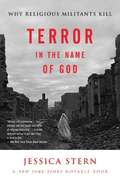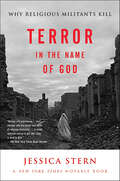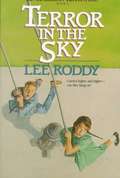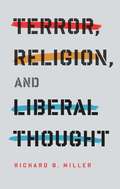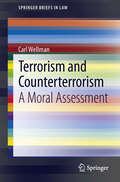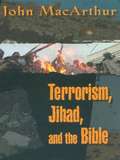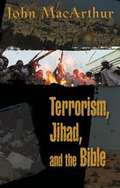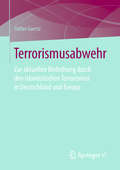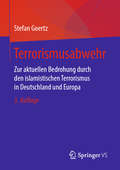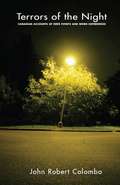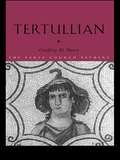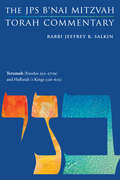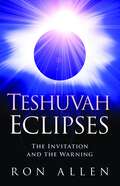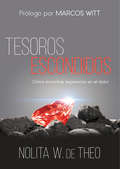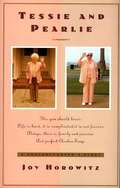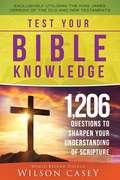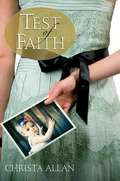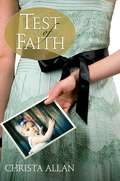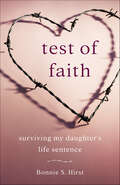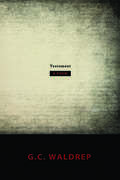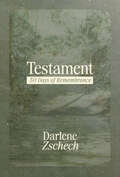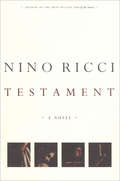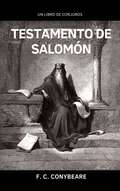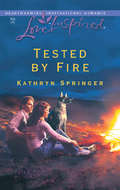- Table View
- List View
Terror in the Name of God: Why Religious Militants Kill
by Jessica SternFor four years, Jessica Stern interviewed extremist members of three religions around the world: Christians, Jews, and Muslims. Traveling extensively—to refugee camps in Lebanon, to religious schools in Pakistan, to prisons in Amman, Asqelon, and Pensacola—she discovered that the Islamic jihadi in the mountains of Pakistan and the Christian fundamentalist bomber in Oklahoma have much in common. Based on her vast research, Stern lucidly explains how terrorist organizations are formed by opportunistic leaders who—using religion as both motivation and justification—recruit the disenfranchised. She depicts how moral fervor is transformed into sophisticated organizations that strive for money, power, and attention. Jessica Stern's extensive interaction with the faces behind the terror provide unprecedented insight into acts of inexplicable horror, and enable her to suggest how terrorism can most effectively be countered. A crucial book on terrorism, Terror in the Name of God is a brilliant and thought-provoking work.
Terror in the Name of God: Why Religious Militants Kill
by Jessica SternFor four years, Jessica Stern interviewed extremist members of three religions around the world: Christians, Jews, and Muslims. Traveling extensively—to refugee camps in Lebanon, to religious schools in Pakistan, to prisons in Amman, Asqelon, and Pensacola—she discovered that the Islamic jihadi in the mountains of Pakistan and the Christian fundamentalist bomber in Oklahoma have much in common.Based on her vast research, Stern lucidly explains how terrorist organizations are formed by opportunistic leaders who—using religion as both motivation and justification—recruit the disenfranchised. She depicts how moral fervor is transformed into sophisticated organizations that strive for money, power, and attention.Jessica Stern's extensive interaction with the faces behind the terror provide unprecedented insight into acts of inexplicable horror, and enable her to suggest how terrorism can most effectively be countered.A crucial book on terrorism, Terror in the Name of God is a brilliant and thought-provoking work.
Terror in the Sky (Bethany House's The American Adventure #6)
by Lee RoddyFrom the book: Hildy Corrigan felt like the first day of school would never come! Ever since their family had arrived in California, her hopes and dreams were all focused on the Lone River Grammar School. If Hildy proves herself to be an excellent student, her goal of attending college to become a teacher and to someday get her "forever home" has a chance of becoming a reality. Being the oldest child of poor parents in the Great Depression, it is Hildy's only chance. But the odds against her are very high. Good grades are one thing, but college also requires money and even with her part-time job after school, she'll never earn enough. When a cash prize is offered for the top academic and civic-minded seventh-grader, Hildy's determination to win it is met by a school administration firmly set against her. She's an unwelcomed outsider, an "Okie," and Hildy and her cousin Ruby are in for big problems at school. The rescue of a kidnapped child becomes an even greater problem. What difference can Hildy make? THE TERROR THEY FACE COULD END HILDY'S STORY!
Terror in the Stadium (Left Behind: The Kids #17)
by Tim Lahaye Jerry B. Jenkins Chris FabryJudd and Lionel fly to Jerusalem with Mr. Stein for the Meeting of the Witnesses. Meanwhile at the schoolhouse, the kids discover a secret underground passage, and Vicki tries to persuade Melinda not to turn them in to the Global Community. Excitement builds as the witnesses converge on Jerusalem to begin their meetings. But will Nicolae keep his promise of safety for all who attend? Join the Young Trib Force as they continue to learn from Tsion Ben-Judah and try to evade their enemies.
Terror, Religion, and Liberal Thought (Columbia Series on Religion and Politics)
by Richard MillerReligious violence may trigger feelings of repulsion and indignation, especially in a society that encourages toleration and respect, but rejection contradicts the principles of inclusion that define a democracy and its core moral values. How can we think ethically about religious violence and terrorism, especially in the wake of such atrocities as 9/11?Known for his skillful interrogation of ethical issues as they pertain to religion, politics, and culture, Richard B. Miller returns to the basic tenets of liberalism to divine an ethical response to religious extremism. He questions how we should think about the claims and aspirations of political religions, especially when they conflict so deeply with liberal norms and practices, and he suggests how liberal critics can speak confidently in ways that respect cultural and religious difference.Miller explores other concerns within these investigations as well, such as the protection of human rights and a liberal democratic commitment to multicultural politics. In relating religion and ethics, he develops a new lens for viewing political religions and their moral responsibilities. This probing inquiry also forces us to rethink our response to 9/11.
Terrorism and Counterterrorism
by Carl WellmanThis book presents a definition of terrorism that is broad and descriptive and much needed to prevent misunderstanding. The book identifies the features that make terrorism 'wrong', including coerciveness, the violation of rights and undermining of trust. Next, it evaluates reasons given for terrorism such as the protection of human rights and the liberation of oppressed groups as not normally justified. Following this, the book identifies and evaluates international responses to terrorism, taking into account General Assembly and Security Council resolutions, United Nations conventions and criminalization in international law. It also looks at national responses which often take the shape of surveillance, detention, interrogation, trials, targeted killings, intrusion and invasion. Finally, the book discusses how, if at all, the moral norms of personal morality apply to the actions of nation states.
Terrorism, Jihad, and the Bible
by John MacarthurSeptember 11, 2001 saw the deadliest attack ever launched on American soil, leaving us asking questions such as: Why did God permit such a thing to happen? Was the attack a divine judgment or was it merely an atrocity perpetrated by the forces of evil? How can human beings be capable of such diabolical savagery in the name of religion? And what is the right course of action for our government to take? John MacArthur points us to the Bible for answers to these and many other questions arising out the recent atrocities. He educates readers to the roots of the conflict, linking the religious and political issues that underlie the current turmoil to the Old Testament.
Terrorism, Jihad, and the Bible: A Response to the Terrorist Attacks
by John MacarthurSeptember 11, 2001 saw the deadliest attack ever launched on American soil, leaving us asking questions such as: Why did God permit such a thing to happen? Was the attack a divine judgment or was it merely an atrocity perpetrated by the forces of evil? How can human beings be capable of such diabolical savagery in the name of religion? And what is the right course of action for our government to take? John MacArthur points us to the Bible for answers to these and many other questions arising out the recent atrocities. He educates readers to the roots of the conflict, linking the religious and political issues that underlie the current turmoil to the Old Testament.
Terrorismusabwehr: Zur Aktuellen Bedrohung Durch Den Islamistischen Terrorismus In Deutschland Und Europa
by Stefan GoertzDieses Buch analysiert mögliche Mittel und Maßnahmen zur Terrorismusabwehr in Deutschland und Europa. So werden u.a. die Akteure der Terrorismusabwehr behandelt. Es erfolgt eine dezidierte Analyse der möglichen Mittel der Terrorismusabwehr wie z.B. Videoüberwachung des öffentlichen Raumes. Außerdem behandelt dieses Buch die Thematik islamistischer Gefährder, in dem die Kategorisierung, Abschiebung, Überwachung und Präventionsprogramme analysiert werden. Ebenfalls wird die Bekämpfung der Terrorismusfinanzierung untersucht.Der InhaltAnalyse der aktuellen Bedrohung durch den islamistischen Terrorismus in Deutschland und Europa • Ausgewählte besondere Bedrohungen durch den islamistischen Terrorismus und institutionelle Antworten • Technische Mittel zur Terrorismusabwehr • Institutionelle Bekämpfung des islamistischen Terrorismus in Deutschland und Europa • Radikalisierung im Phänomenbereich Islamismus und islamistischer Terrorismus sowie PräventionDie ZielgruppenPolitikwissenschaft, Terrorismusforschung, Politische Bildung, Polizei, Nachrichtendienste, BundeswehrDer AutorDr. Stefan Goertz ist Beamter der Bundespolizei und augenblicklich Dozent für Politikwissenschaft an der Hochschule des Bundes, Fachbereich Bundespolizei, in Lübeck.
Terrorismusabwehr: Zur aktuellen Bedrohung durch den islamistischen Terrorismus in Deutschland und Europa
by Stefan GoertzDieses Buch analysiert einführend ausführlich die aktuelle und zukünftige Bedrohung durch den islamistischen Terrorismus in Deutschland und Europa. Dabei werden sowohl in Deutschland und Europa verübte als auch von den Sicherheitsbehörden verhinderte islamistische Anschläge auf ihre Taktik und Wirkmittel hin analysiert und potenzielle zukünftige Anschlagsszenarien erklärt. Auf der Ebene der Akteure, Mittel und Maßnahmen der Terrorismusabwehr werden u.a. islamistische „Gefährder“ und technische Mittel wie die Videoüberwachung des öffentlichen Raumes beleuchtet. Ausführlich wird die Bekämpfung der Terrorismusfinanzierung dargelegt und die deutschen und europäischen Institutionen der Terrorismusabwehr werden vorgestellt. Stark erweitert wurde das Kapitel sechs, „Radikalisierung im Phänomenbereich Islamismus, Salafismus und islamistischer Terrorismus sowie Prävention“. Dort wird der aktuelle Stand der deutschen und internationalen Sozialwissenschaft zur Radikalisierungsforschung dargelegt und erstmals islamistische, salafistische und jihadistische Radikalisierung in Justizvollzugsanstalten analysiert. Abschließend werden in diesem Kapitel Präventions- und Deradikalisierungsprojekte gegen Islamismus, Salafismus und islamistischen Terrorismus untersucht.
Terrors of the Night: Canadian Accounts of Eerie Events and Weird Experiences
by John Robert ColomboTerrors of the Night is a collection of more than 100 accounts of eerie events and weird experiences that have been recorded by Canadians over the last 400 years. These incredible accounts come from all parts of the country and concern witchcraft, peculiar weather conditions, wild beasts, hardly human creatures, omens, prophecies, powers beyond ours, miraculous cures, and bizarre behaviour generally. The narratives, often in the words of witnesses themselves, are taken from the columns of old newspapers, journals, and correspondence. It is an engrossing and unsettling experience to read these stories because the reader keeps asking the question, "Could such things happen?"
Tertullian (The Early Church Fathers)
by Geoffrey D. DunnThis book is the first accessible introduction in English to Tertullian's works, providing translations of Adversus Iudaeos (Against the Jews), Scorpiace (Antidote for the Scorpion's Sting) and De Verginibus Velandis (On the Veiling of Virgins). Tertullian (c. AD 160 - 225) was one of the first theologians of the Western Church and ranks among the most prominent of the early Latin fathers. His literary output is wide-ranging, and provides an invaluable insight into the Christian Church in the crucial period when the Roman Empire was in decline. These crucial works studied, together with Geoffrey D. Dunn's comprehensive commentary, illuminate the early church's reaction to paganism, Judaism, Scripture, and its development of a distinctive Christian ethic.
Terumah: The JPS B'nai Mitzvah Torah Commentary (JPS Study Bible)
by Rabbi Jeffrey K. SalkinTerumah (Exodus 25:1-27:19) and Haftarah (1 Kings 5:26-6:13): The JPS B’nai Mitzvah Torah Commentary shows teens in their own language how Torah addresses the issues in their world. The conversational tone is inviting and dignified, concise and substantial, direct and informative. Each pamphlet includes a general introduction, two model divrei Torah on the weekly Torah portion, and one model davar Torah on the weekly Haftarah portion. Jewish learning—for young people and adults—will never be the same. The complete set of weekly portions is available in Rabbi Jeffrey K. Salkin’s book The JPS B’nai Mitzvah Torah Commentary (JPS, 2017).
Teshuvah Eclipses: The Invitation and The Warning
by Ron AllenIn Teshuvah Eclipses, Ron Allen explains how a 2017 natural phenomenon brings a solemn admonition for Americans to return to their Christian foundation. He reveals how such eclipses: • Marked the rise of the U.S. and Israel as nations• Gave prophetic warnings for nations to repent or face disaster • Sparked the birth of Messianic Judaism • Encourage Christian unity in answer to the prayer of Jesus in John 17 Accept the Teshuvah invitation to repent and return to God. Pray earnestly for God to heal the land before it is too late.
Tesoros escondidos: Cómo encontrar esperanza en el dolor
by NOLITA W. DE THEOSoledad, Depresión, Dolor. Estas son algunas de las palabras que describen los tiempos de sufrimiento que en ocasiones enfrentamos en la vida. No obstante, independientemente de cuál sea la circunstancia esos valles emocionales pueden tornarse en las etapas donde más conocemos a Dios íntimamente. Esos valles son capaces de transformarse en: PAZ, ALEGRIA, BIENESTAR. En Tesoros escondidos, Nolita W. de Theo comparte su experiencia con la depresión tras la pérdida de dos embarazos muy deseados. Theo utiliza ejemplos bíblicos y personales para demostrar cómo en medio de las pruebas y los sufrimientos el Señor nos sostiene con su amor y nos muestra el propósito detrás de las vivencias difíciles.
Tessie and Pearlie: A Granddaughter's Story
by Joy Horowitz"Tessie and Pearlie" is Joy Horowitz's moving, poignant memoir of her two grandmothers, both in their 90s, both immigrants, but with very different personalities.
Test Your Bible Knowledge: 1,206 Questions to Sharpen Your Understanding of Scripture
by Wilson CaseyPeople are passionate when it comes to the Lord?s word, as the Holy Bible has remained in the top-most rank of bestselling books of all time. Test Your Bible Knowledge is a fun, informative, and entertaining way to see how well you know the Good Book. Trivia expert and author Wilson Casey has compiled 1,206 fascinating questions about the people, history, stories, and facts from the Bible. Each page is a separate quiz with six enlightening and fresh questions with multiple-choice answers. In addition, every correct answer includes references to the relevant chapter and verse in scripture for further study and clarification. It?s the perfect companion for the multitudes wanting to test their biblical knowledge (and keep score if desired). The quizzes cover the entire scope of the Holy Bible, exclusively based on the beloved King James Version. Readers may play as many of the quizzes as desired per sitting, and can skip around or complete them in order. And for easy lookup and reference, there?s a thorough index at the book?s end. Whatever your age, Test Your Bible Knowledge guarantees hours of enlightening fun.
Test of Faith
by Christa AllanWithout warning, Elle Butler's 15-year-old secret-named Faith--shows up on her doorstep. Abandoned by her adoptive mother, Faith sets off a chain reaction that threatens to destroy the fragile balance of Elle's life with her husband, Langdon, who is campaigning for State Representative. Already damaged by the stress of his campaign, their marriage is fractured even more when Elle reveals that not only did she give up a baby for adoption, but that the child is Langdon's. Faith is the daughter he never knew he had. As the three battle the gauntlet of challenges brought on by their unplanned reunion, they carefully navigate the watchful eyes of an unforgiving political public. Trying to forge her way back to her husband, Elle runs into the God she thought had abandoned her. And when Faith's adoptive father returns, Elle and Langdon learn true selflessness in helping Faith finally find her way home.
Test of Faith
by Christa AllanWithout warning, Elle Butler's 15-year-old secret-named Faith--shows up on her doorstep. Abandoned by her adoptive mother, Faith sets off a chain reaction that threatens to destroy the fragile balance of Elle's life with her husband, Langdon, who is campaigning for State Representative. Already damaged by the stress of his campaign, their marriage is fractured even more when Elle reveals that not only did she give up a baby for adoption, but that the child is Langdon's. Faith is the daughter he never knew he had. As the three battle the gauntlet of challenges brought on by their unplanned reunion, they carefully navigate the watchful eyes of an unforgiving political public. Trying to forge her way back to her husband, Elle runs into the God she thought had abandoned her. And when Faith's adoptive father returns, Elle and Langdon learn true selflessness in helping Faith finally find her way home.
Test of Faith: Surviving My Daughter's Life Sentence
by Bonnie S. HirstBonnie S. Hirst is a woman of faith who has always believed that everything in life works out for the best. So, when her daughter, Lacey, is accused of a terrible crime, although Bonnie is devastated, she is also convinced that God will protect her family from harm. He always has, after all. But when her prayers are not answered and Lacey is sentenced to life in prison, Bonnie questions every aspect of her existence: her beliefs, her role as a mother, and the purpose behind the events that are tearing her family apart. As Bonnie and her family navigate the complicated labyrinth of the legal system, she struggles with the duality of presenting a façade of being okay on the outside and screaming for air on the inside. Finally, she is guided to ask for help—a concept previously foreign to her—and is rewarded with a bubble of friends who surround her and her family with love. Poignant, hopeful, and ultimately uplifting, Test of Faith is the story of one mother’s spiritual journey of awareness—and her discovery that even when your life seems to have radically veered off course, there are always blessings to be found, if you can just keep your heart open enough to receive them.
Testament
by G.C. WaldrepIn this book-length poem, G.C. Waldrep addresses matters as diverse as Mormonism, cymatics, race, Dolly the cloned sheep, and his own life and faith. Drafted over twelve trance-like days while in residence at Hawthornden Castle, Waldrep responds to such poets as Alice Notley, Lisa Robertson, and Carla Harryman, and tackles the question of whether gender can be a lyric form.G.C. Waldrep's books include Disclamor (BOA Editions Ltd., 2007) and Your Father on the Train of Ghosts (BOA Editions, Ltd., 2011). He lives in Lewisburg, Pennsylvania, where he teaches at Bucknell University, edits West Branch, and serves as editor-at-large for the Kenyon Review.
Testament: 30 Days of Remembrance
by Darlene ZschechThis immersive journey into worship and reflection pairs daily devotions from Darlene Zschech with her iconic songs, offering a powerful combination of Scripture, music, and personal insights to deepen your faith. Song and Scripture come together in this beautiful interweaving of worship, faith, and spiritual growth. Testament is a unique devotional experience that provides: Thirty devotions that expand on themes in Darlene&’s songs such as &“Shout to the Lord,&” &“In Jesus&’ Name,&” and &“Here I Am, Send Me&” Biblical insights into why God calls us to worship individually and communally Daily spiritual nourishment and application through stories and reflections from Darlene QR codes that lead to a multi-sensory devotional time incorporating Darlene&’s songs and additional content With her years of experience and passion for worship, Darlene brings a rich perspective to every devotion in Testament as she connects the messages of her songs with the truths of Scripture.
Testament: A Novel
by Nino RicciA stunning fictional biography, Testament presents the earthly life of Jesus from the perspectives of four fascinating figures. In powerful accounts colored by their own beliefs and desires, the following men and women tell the captivating story:Yihuda of Qiryat (Judas Iscariot), a freedom fighter working for Rome's overthrow who is drawn to the charismatic teacher; Miryam of Migdal (Mary Magdalene), a disciple who finds in Jesus' presence the intellectual stimulation that society has denied her; Miryam (Mary), the mother of Jesus, who has a complex relationship with her precocious son; Simon of Gergesa, a plainspoken shepherd who travels to Jerusalem and witnesses the last days of the Jewish preacher.With exquisite detail, Nino Ricci offers a vivid and provocative portrait of the historical Jesus, an ordinary man living in a time of political turmoil and spiritual uncertainty. TEST
Testamento de Salomón
by F. C. ConybeareEl Testamento de Salomón, muy valorado por los practicantes y estudiosos del ocultismo, es un texto compuesto pseudoepigráfico atribuido al rey Salomón, pero no considerado como escritura canónica por los judíos o los grupos cristianos. Fue escrito en lengua griega, basándose en precedentes que se remontan a principios del primer milenio, pero probablemente no se completó en ningún sentido textual significativo hasta algún momento del periodo medieval. En sus recensiones más notables, el texto describe cómo Salomón pudo construir su templo ordenando a los demonios por medio de un anillo mágico que le confió el arcángel Miguel.
Tested by Fire
by Kathryn SpringerScarred ex-cop John Gabriel didn' t need anyone else' s problems, but he couldn' t refuse a request from his former chief. Until John learned what the favor to Chief Kelly entailed: keeping an eye on his granddaughter, Fiona, a young police officer facing a dangerous work situation. John quickly saw that Fiona was in trouble-- the fiery redhead lacked departmental support as she investigated a serial arsonist. And when the attractive rookie was trapped in a burning building, John was the one who ended up rescuing her. Yet could Fiona' s strong faith rub off on the cynic and make John believe in the Lord... and in the love that was miraculously blossoming in the stony soil of his heart?
